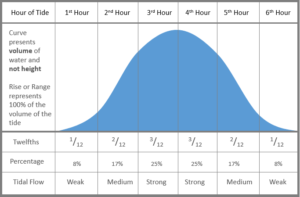Tides
What causes them, how to read them, how to calculate them

Here on Earth, 70% of the surface of this planet is covered by water, and this water is connected by areas called oceans. While Earth spins in an axis, the water on the earths surface is effected by gravitational pull from the earths moon, and the sun in this solar system. The effect the moon has on our tides is about 2.2 times more than the sun, but this is enhanced if the moon and the sun are in alignment on the same side of our planet.
Now in most places, you’ll nearly get two high tides and two low tides every day, with it being a 24hr and 50 minute cycle, which makes it change sightly every day.
Now thats the general understanding of the tides, but looking beyond the surface it becomes a little more involved. The ocean has currents, so these effect how places like bays Flood (in coming tide) and Ebb (outgoing tide), and if you live in a river connected to the ocean, there is a time delay in the tide, and also resistance as the water tries to work it’s way up stream.
The tidal effect the moon has on the earths surface isn’t just restricted to the ocean, even on land, the ground surface will raise about 30cm in each daily rotation.
Because earth has an atmosphere, it also has an effect on the tide. Atmospheric pressure holds the water down equally, but weather systems like storms create areas of high and low pressure, and areas of low pressure means that there is less pressure on the water surface, so it rises causing a “Storm Surge”, or a surge of tidal water that can flood low lying areas. This can also be worsened by rain flood waters from the storm.
The rule of twelfths.
While the water depth travels vertically, you have to imagine that the time it takes travels around a clock face, so from 12 o’clock to 1 o’clock, it’s one hour , but on a clock face it’s more beside the 12 than below it, so in the first hour after a tidal change you’ll only see a 1/12th of the tidal movement. As you get closer to half tide, the speed of flow increases, with half of the tide moving in the 3rd and 4th hour of the tide. It’s this part of the tide that catches people out.
On a day with 2 metres of tidal range, or, 2 metres of distance between low and high tide, you’ll see the water drop 1 metre in the space of 2 hours on an out going tide during 3rd and 4th hour. This is particularly a problem for Jet Skiers at tourist spots, and people who have pulled up to beach camping areas and have their boat on the sand.
Jet Ski’s and runabouts are generally too heavy for just a couple of people to move and you either have to wait for the tide to come back, or have a large vessel tow you off the beach back in to the water.

So, every once in a while, you’ll come across someone who has run around at a very high, or King tide. This is particularly bad, as the water level won’t be that high again for a month. The vessel essentially has about 15 minutes to discharge as much unnecessary cargo that it has on board, like fresh water storage, and run it’s engines at near maximum thrust to resolve the situation. Now it’s most likely gone on bow first, so using thrust forward generally isn’t the answer. I’d first gauge where the deeper water is around your location, and work out how best to get there, it may be using reverse in bursts, sometimes alternating full lock to wiggle the vessel off may assist in your efforts. Within 20 minutes, you’ll either be floating again or stuck there for between 5 – 24 hours, as the next high tide may not be high enough to float you off.
Where to find Tide Calendars
In Australia, it’s really easy just CLICK HERE and it will lead you to the Bureau of Meteorology website where you can just click on the map and select your local area.
Remember the 7 P’s, Proper Prior Preparation and Planning Prevents Poor Performance.

